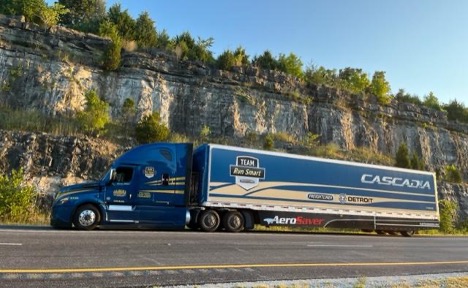.jpg.aspx)
Have you ever noticed that many heavy haul operations drive around with a truck and trailer that can have a multitude of axles riding under it? Dump trucks, tow trucks, and cement mixers have all adopted adaptable axle configurations. You may be asking what I mean by adaptable axle configurations. Quite simply, it would be ridiculous for a multiple axle heavy hauler to go down the highway with more axles and tires engaging the roadway than necessary. So, back to adaptability in the heavy haul dump truck and tow truck segments of the transportation industry; it’s quite common to have axles that retract when not needed.
Having axles lifted off the ground adds to efficiency, reduces toll road fees in many cases, and increases maneuverability. My question is: “What’s taken the linehaul industry so long to embrace adaptable axle configurations?”. Nearly everyone would find it ridiculous for a “quad axle” dump truck to drive down the road with all of its tires on the ground when it's empty. In this scenario, after the dump truck is empty, it returns to pick up its next load on only three axles instead of five. The same goes for heavy haul where they’ll have a “tri axle” tractor where the lead pusher axle is none powered, and liftable when not needed.
On my newest truck, Celeste, I’ve truly taken a page out of “heavy haul” and applied it to line haul. Currently, what we’ve done is employ the Hendrickson Optimaax liftable pusher axle in combination with the Hendrickson liftable trailer axle. This allows me the versatility of operating on a total of three axles, and up to five axles when the loads require. This setup has yielded my operation incredible efficiency with loads varying from 45,000 lbs all the way down to 5,000 – 6,000 lbs when I carry loads of insulation.
A particular run that I encounter is a route to New Jersey. For those of you who don't know, the Garden State doesn’t charge you to cross into New Jersey but does charge you a toll to leave. The toll is charged by the number of axles on the ground. When I leave, I’m only on three axles. By reducing the number of tires on the ground, I’m not only reducing fuel consumption and tire wear, but I’m also capitalizing on a lower toll rate. This reduces my cost to leave the fine state of New Jersey by $14.00.
Our ‘22 Freightliner Cascadia, Celeste, now has 68,003 miles and a lifetime fuel mileage of 10.33. For the first 50,000 miles, I was still conducting Project 70+/10 where the goal was to average double-digit fuel economy while traveling at speeds up to 75 miles per hour, where safe, legal, and applicable. Unfortunately, we never quite got to the goal, as later calculations had us settle at 9.8 miles to the gallon. Since then, due to high fuel prices and traffic moving at a slower pace, I’ve suspended Project 70+/10.
Currently, I’ve slowed down to cruise speeds between 62 and 65 mph unless posted slower. This slower pace has really made for a large efficiency increase with the last 10 fill-ups, coming in at 10.75, 10.07, 11.74, 10.31, 10.41, 10.82, 10.22, 11.08, 11.87, and 11.58. During this time period, the loads have weighed between 6,000 lbs and 35,000 lbs.
To say I’m pleased with the numbers would be an understatement. Also, I’m much more relaxed at the end of my work week by having slowed down.
Let's take a look at axle configurations that have been used for years in other segments of the trucking industry, and take a page out of heavy haul's playbook and apply it to linehaul.